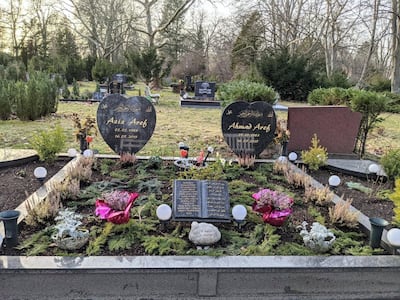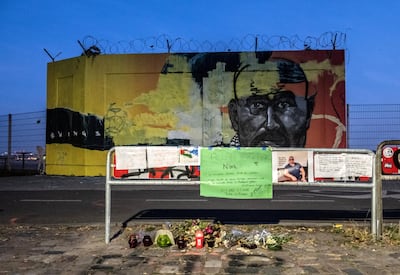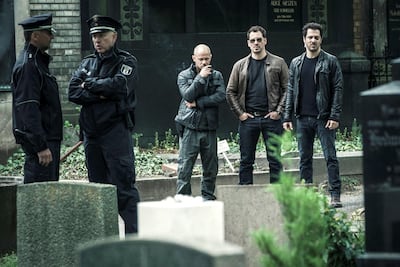Between the tombs of Ottoman envoys and rows of war graves, memorials in Berlin’s Turkish cemetery pay tribute to the powerful Arab mafia families who made a fortune in Germany after fleeing civil war in Lebanon in the 1970s.
The funeral of two brothers, whose deaths in a car accident in 2015 sparked fears of a battle for control over the city’s prostitution and drugs trade, attracted such large numbers that police were forced to close the road because of the parked limousines.
The graves of Aziz and Ahmad Aref – known as the godfathers of the underworld – appear at the centre of a map of sites associated with the city’s notorious clans drawn up by bloggers seeking, with a strong hint of irony, to show their “pop cultural, tourism potential”.
Police efforts to clamp down on the illegal activities of the gangs have captured the German public’s imagination, with near-weekly raids, court cases and heists inspiring new levels of popular interest in the already notorious crime families.
Middle East-dominated gangs were responsible for a crime every eight hours in Berlin in 2020 and the violent nature of clan crime has become entangled in the fierce debate about the integration of migrants in Germany.
The map features the grave of Nidal Rabih, a reputed gangland enforcer who spent more than a decade in prison before he was gunned down by a rival clan in a park at the age of 36, in front of his family.
His funeral in Schoeneberg was attended by thousands of people from around the country, including the heads of Berlin’s most notorious clans. In the days after the hit on the Lebanese-born Palestinian, police stood guard as municipal workers in the Berlin district of Neukoelln – a crowded maze of streets thronging with Arab-owned businesses – washed away a mural near the scene depicting him as an extremist fighter.
About one in five of Neukoelln’s residents are of Middle Eastern origin. Long considered home turf for Berlin’s Arab gangs, it is gentrifying rapidly, with trendy coffee shops and fashion outlets catering for an influx of hipsters seeking cheaper rent and authentic falafel.
Two worlds collide on Sonnenallee, known as Berlin’s Arab Street, where sports cars with blacked-out windows lurk in the side streets behind shawarma joints. Organic supermarkets compete for space with Arab-owned jewellers.
The grime and faded grandeur of Neukoelln has provided the backdrop for television producers who are keen to move away from the tropes of Berlin as a place of Cold War intrigue or 1920s glamour, trying instead to tap into surging interest in Berlin’s criminal underground.
Four Blocks, a drama telling the story of a fictional Lebanese crime family, was a runaway success when it debuted in 2017 and won praise from critics for its gritty and realistic portrayal of the German capital's underbelly.
Shot on location in Neukoelln, the series was inspired by real events. The second series depicts a feud between the clan and a Chechen rival gang, echoing a real-life rivalry that has often spilled over into violence in recent years and has become a major concern for police.
In November last year, a mass brawl involving dozens of members of the Remmo clan and a Chechen rival group set off a wave of clashes and reprisals. Witnesses saw the gangsters fighting with knives, furniture and hookah pipes outside a local shop in Neukoelln. Police in February carried out extensive raids in response to the violence.

High-profile court cases have revealed some of the sprawling business interests of clan associates, and the map offers visitors to Berlin a chance to sample the gangster lifestyle.
On the edge of the upmarket neighbourhood of Wilmersdorf sits Brando’s, a hookah cafe frequented by rappers with allegedly close ties to the gangs, and it is believed to be connected to the Remmo clan.
With its spotless streets and grand, imperial-era subway stations, Wilmersdorf is far removed from the Neukoelln neighbourhoods usually associated with gangs. Luxury car dealerships, prisons and restaurants owned or frequented by clan members all appear as stops on a tour of Berlin’s gangland that now covers the length and breadth of the city.
In another sign that clan activity has expanded well beyond Neukoelln’s borders, local media have reported that an increasing number of businesses are the targets of clan extortion rackets.
Many smaller businesses around the city, including florists, hairdressers and hostels – not the types of businesses typically attracting gang attention – have been asked to pay protection money or suffer the consequences.
Few convictions are made on the basis of reported threats, however, and the authorities are concerned that the problem is much larger than official figures show.
Berlin’s Arab crime families are notorious for leading public lives.
The head of the notorious Remmo clan, Issa Remmo, was said to live in an imposing neoclassical villa on a tree-lined avenue of Alt-Buckow, an exclusive suburb.
In April last year, hundreds of clan members and associates gathered outside the villa in defiance of coronavirus restrictions to show their support for the clan boss after the death of his mother.
In a city dominated by large Soviet-era apartment blocks, detached houses such as the stately pile of the Remmo clan are rare.
Now belonging to the state of Berlin, it has long been a symbol of the family’s power, suitable for a man whose family maintains a very visible public profile despite attracting the attention of the authorities.
Berlin's crime families appear regularly in the country's tabloid press, which relays every turn of the police crackdown on their activities to a fascinated public. The starring role Berlin's Arab clans play in the Netflix hit Dogs of Berlin underlines their ascendancy in German pop culture.
Only the second German-language series to be commissioned by the streaming giant, the show follows police investigating the death of a fictional Turkish-German footballer in another tale with close similarities to reality.
The two detectives probe a Lebanese clan, a neo-Nazi group, Turkish nationalists and football fans in a sweeping journey through the German capital’s criminal underworld.
Its popularity shows that the German public’s appetite for gangsters is not waning, even while the police try to stamp out their influence.




